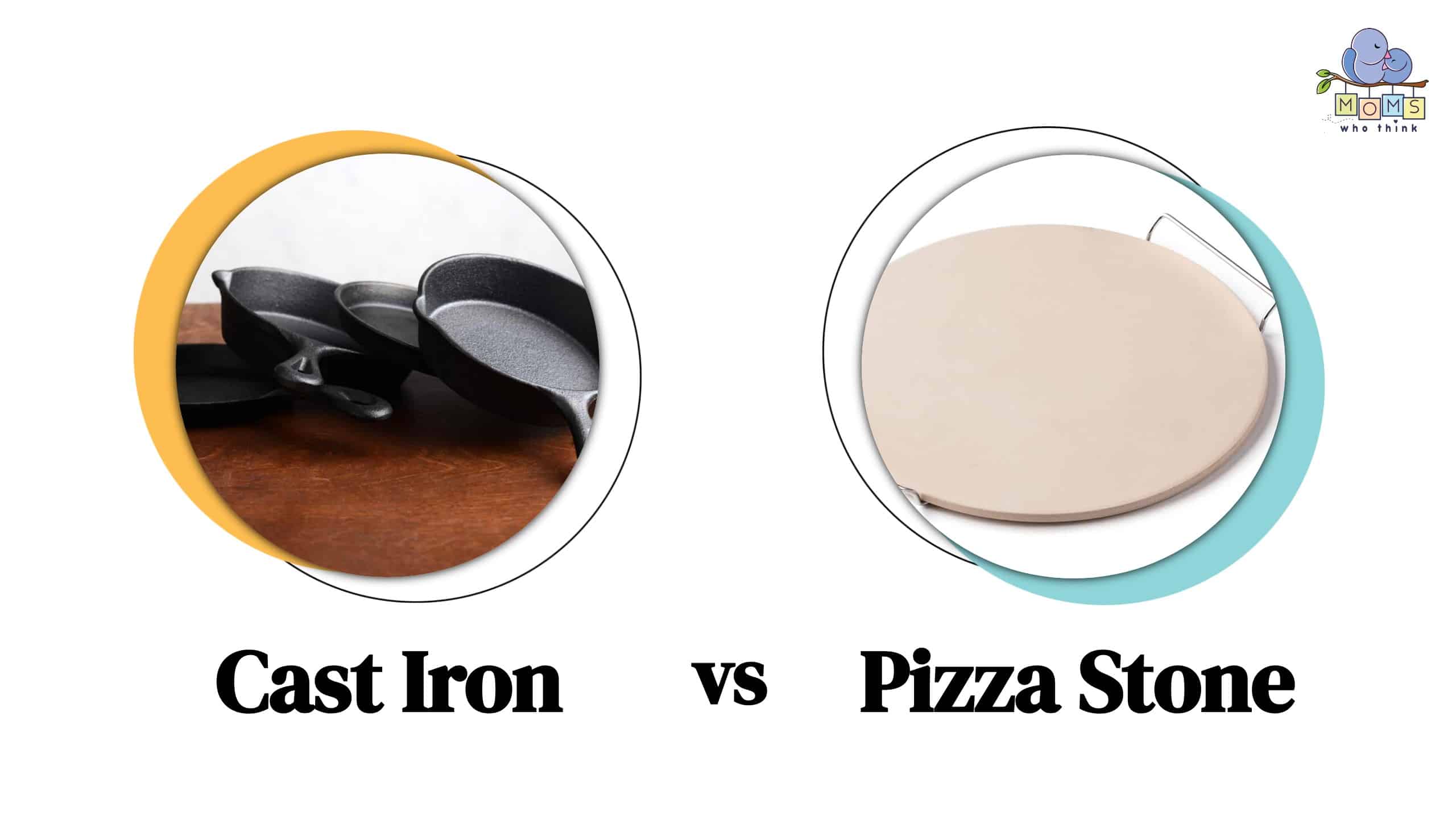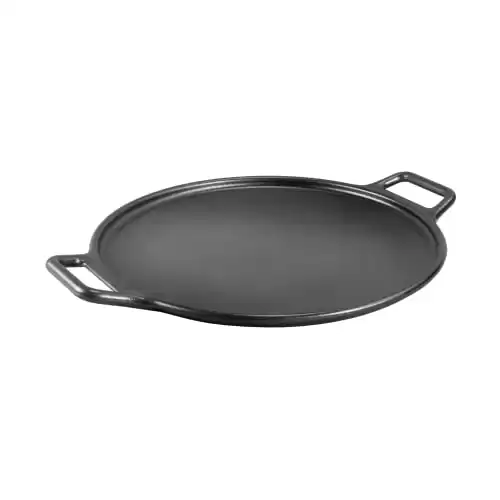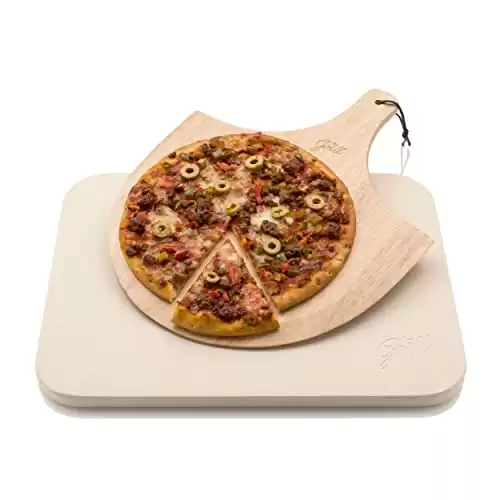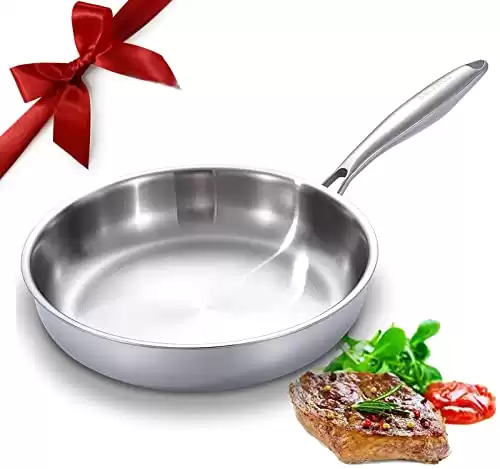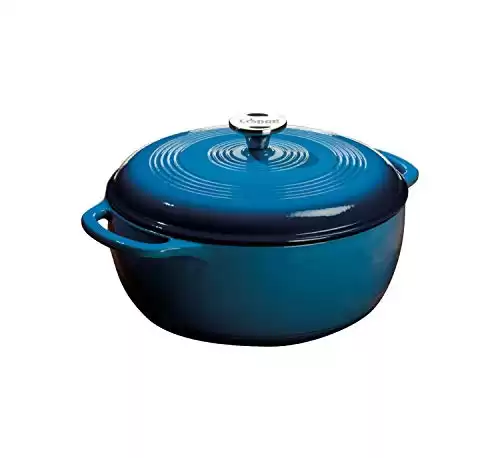Cast iron pans, as the name suggests, are heavy-duty iron pans that retain heat well while pizza stone pans are made of man-made materials that withstand high temperatures. But which one is better for making pizza at home?
Do you prepare a chewy or crisp-crust pizza? Whatever your choice, getting the right equipment helps get the best pizza possible.
These two pans are popular choices for making homemade pizza. Choosing the right one depends on your personal pizza preference, kitchen needs, and habits.
Let’s look at cast iron and pizza stones as viable choices the next time you crave some homemade pizza.
What is a Cast Iron Pan?
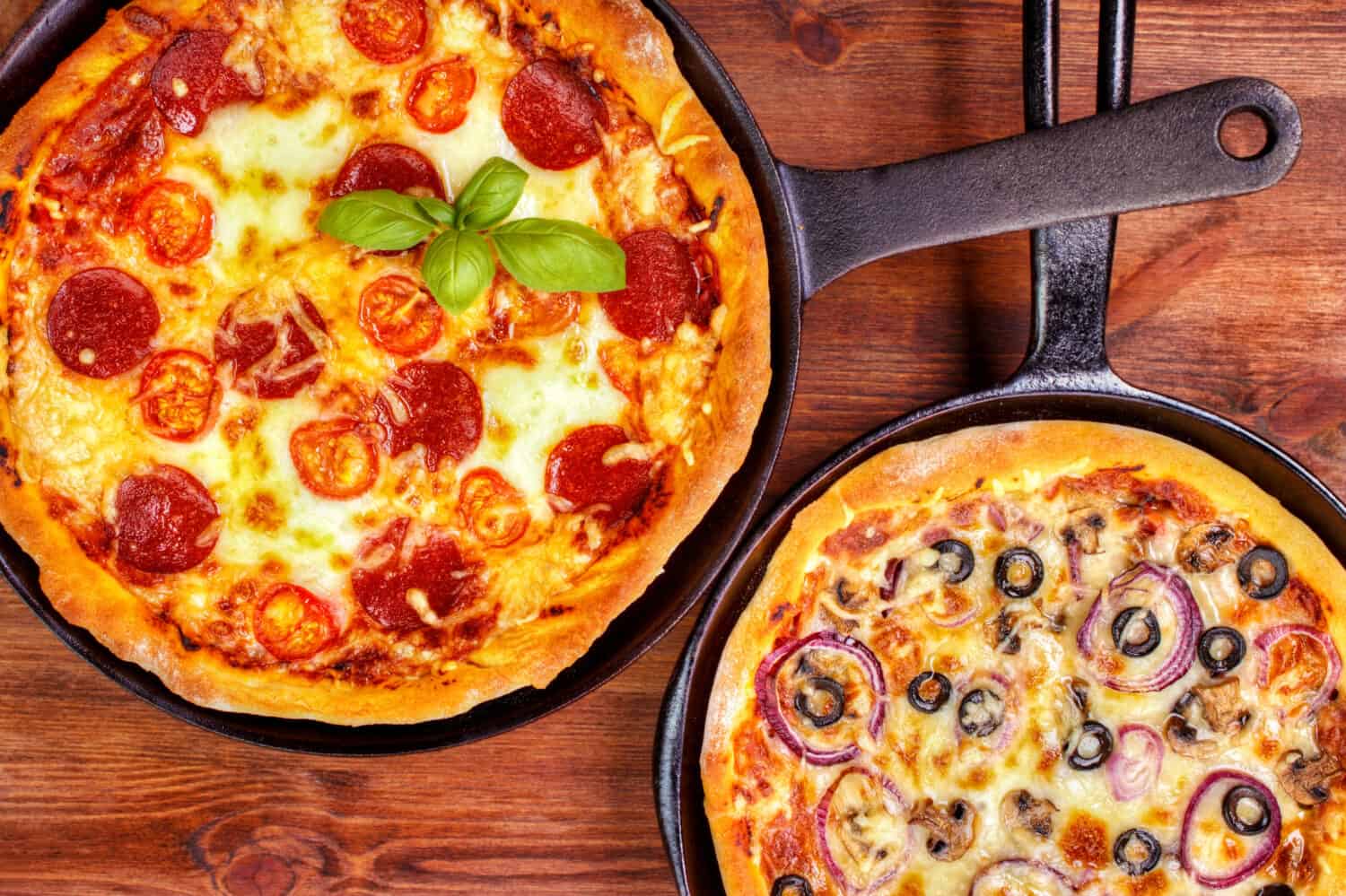
©Ari N/Shutterstock.com
A cast iron pan is a heavy-duty pan made of durable materials. It is extremely durable and can last for long periods. It features a wide design that allows you to make large-sized pizzas.
Cast iron pans heat up quite fast and are pretty durable. Most cast iron pans feature handles on either side, making them very easy to handle. They are also well known for their heat retention properties.
Handling and cleaning cast iron pans is not complicated. The handles allow for easy maneuvering in and out of the oven. Cleaning the pans is also simple as it requires a brush or steel chain. All you need to do is scrub away the dirt using your preferred brush along with your ideal cleaning agents and rinse the pan.
A cast iron pan is ideal when you’re looking to make slightly charred and chewy crust pizzas. The pan is also popular for cooking a variety of foods like steak and vegetables.
Advantages of using a Cast Iron pan:
- Very durable: Cast iron is durable, ensuring that it’s usable for the longest time. The heavy-duty iron construction also assures you of excellent durability. The pans can withstand heavy use and are resistant when occasional dropping occurs.
- Heats up fast: Cast iron heats pretty fast, enabling you to cook your pizza within a short period. This benefit comes in handy when hosting a party.
- Retains heat: Cast iron will also retain heat very well. Once they heat, they retain the heat for longer periods, which is a vital factor when cooking pizza. Excellent heat retention is important for even pizza cooking and a crispy crust.
- Versatility: Cast irons are especially versatile and can be used to cook a wide range of recipes.
- Super easy cleaning: Cast iron is also very easy to clean. All you need is a brush to get rid of all stains including the greasy ones and rinse it with water. You can also use liquid detergents to clean cast iron pans.
Cons of using cast iron:
- Heavy: Cast iron pans are quite heavy and can be quite difficult to move around the kitchen.
- Handles get hot: Cast iron pans handles can get hot making handling difficult.
- Prone to rusting: Being that they are majorly made of iron, cast iron may be prone to rust. Frequent contact with moisture may further hasten rusting.
What is a Pizza Stone?
A pizza stone, on the other hand, is a flat and round surface usually made of natural or man-made materials. They are normally very strong and can withstand extreme temperatures. Pizza stones are designed to mimic traditional brick ovens. They can withstand up to 900ºF.
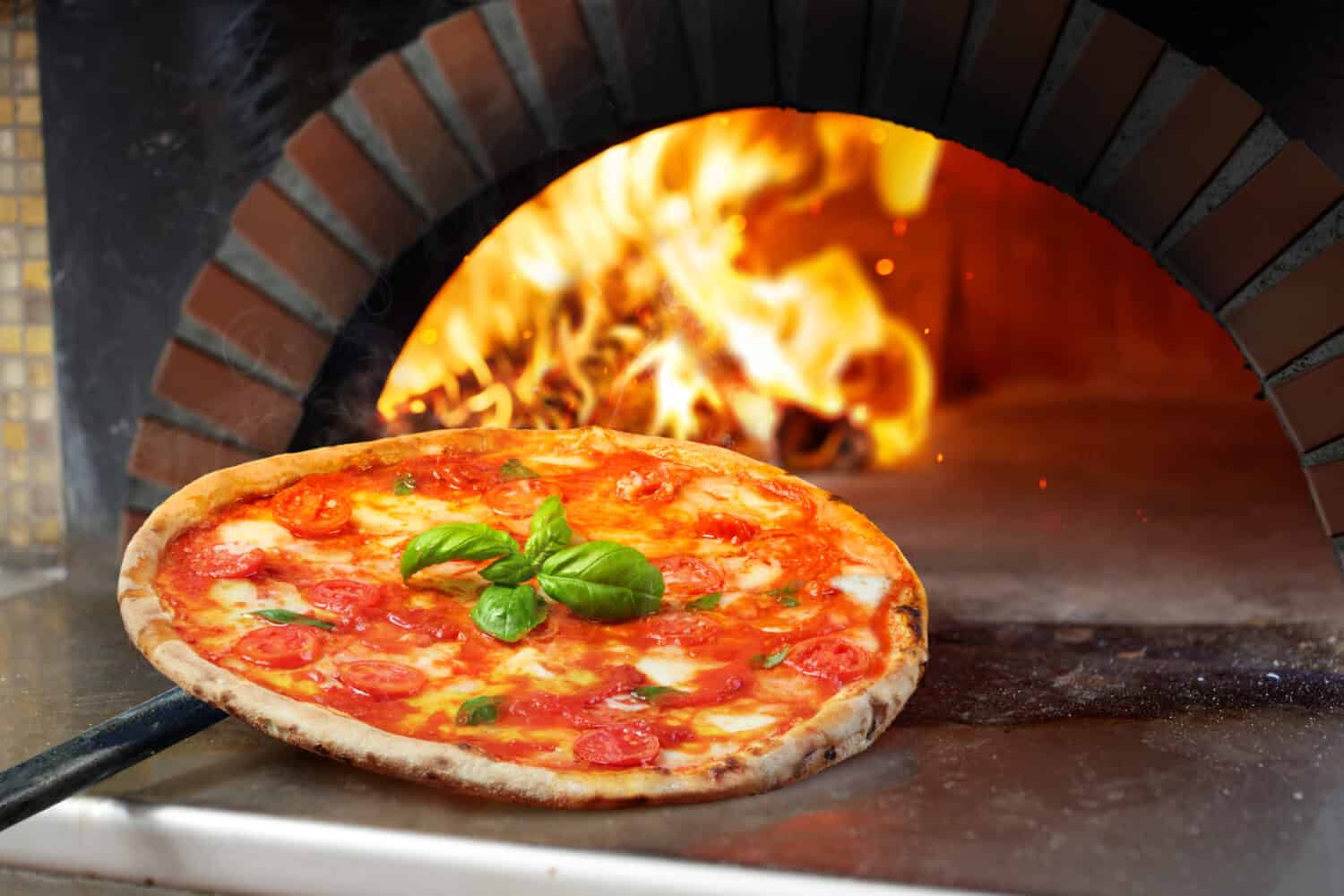
©Romolo Tavani/Shutterstock.com
Most pizza stones are made of clay, ceramic, or cordierite. They also come in different shapes and sizes. Common shapes are rectangular, square, and circular.
The pans create a crisper crust for your pizza. This happens because of the stone surface that penetrates moisture. The moisture forms around the dough while baking in the oven, allowing for a crispy crust.
If you’re looking to make pretty thin-crust pies, then a pizza stone is preferred. But you can choose the pans in varying sizes and thicknesses to match your cooking needs.
Most pizza stone pans range from sizes 10 to 20 inches. The pan thickness may also vary from ½ inch to 1 inch.
- Comes With Free Wooden Peel
- Extra Large 15 x 12" Inch Durable Cordierite Cooking Stone
Advantages of Pizza Stones
- Even Heat Distribution: Pizza stones offer even heat distribution which ensures that all sides of your pizza are cooked proportionately. This results in an evenly cooked and crispy crust.
- Microscopic pores: It also features porous microscopic holes that help absorb moisture from the pizza. This further helps create a crispy crust and prevents your pizza from becoming soggy.
- High-temperature tolerance: Pizza stones can withstand some of the highest temperatures. This is a crucial factor when making the best pizzas. You can make authentic Neapolitan-style pizza using pizza stones. Crusts tend to cook quickly because of the high heat creating a slight char and chewy crust.
- Versatility: Pizza stones are reliable when you need to cook a variety of dishes. You can cook pastries, bread, and other baked foods using pizza stones.
Cons of Pizza Stones
- Longer Preheat time: Pizza stones take at least 30 minutes of pre-heating. This can be inconvenient when you’re short on time and cooking for several people.
- Delicate: Pizza stones can be fragile and easily prone to cracking. They need very careful handling, making it difficult to clean. The US Consumer Product Safety Commission also warns against potential fire when consumers use oils to clean.
- Difficult to clean: The stones can absorb oils from the pizza and other liquids which are pretty difficult to clean. You cannot use liquid detergents to clean them as the stones will absorb the soap.
What are the Differences Between Cast Iron and Pizza Stone?
As mentioned, cast iron and pizza stones are the most popular when making homemade pizza. However, there are a few notable differences when choosing between the two.
The differences play a major role in impacting the ultimate taste and crust appearance of your pizza. Here are some of the major differences:
Material
Cast iron, as the name suggests, is made of iron. They feature a heavy-duty iron construction which is extremely durable. Pizza stones are made of either natural or synthetic materials. Most pizza stones are made of porous materials like cordierite, clay, or ceramic. These are materials that absorb the heat and use it to cook the pizza.
Heat conductivity
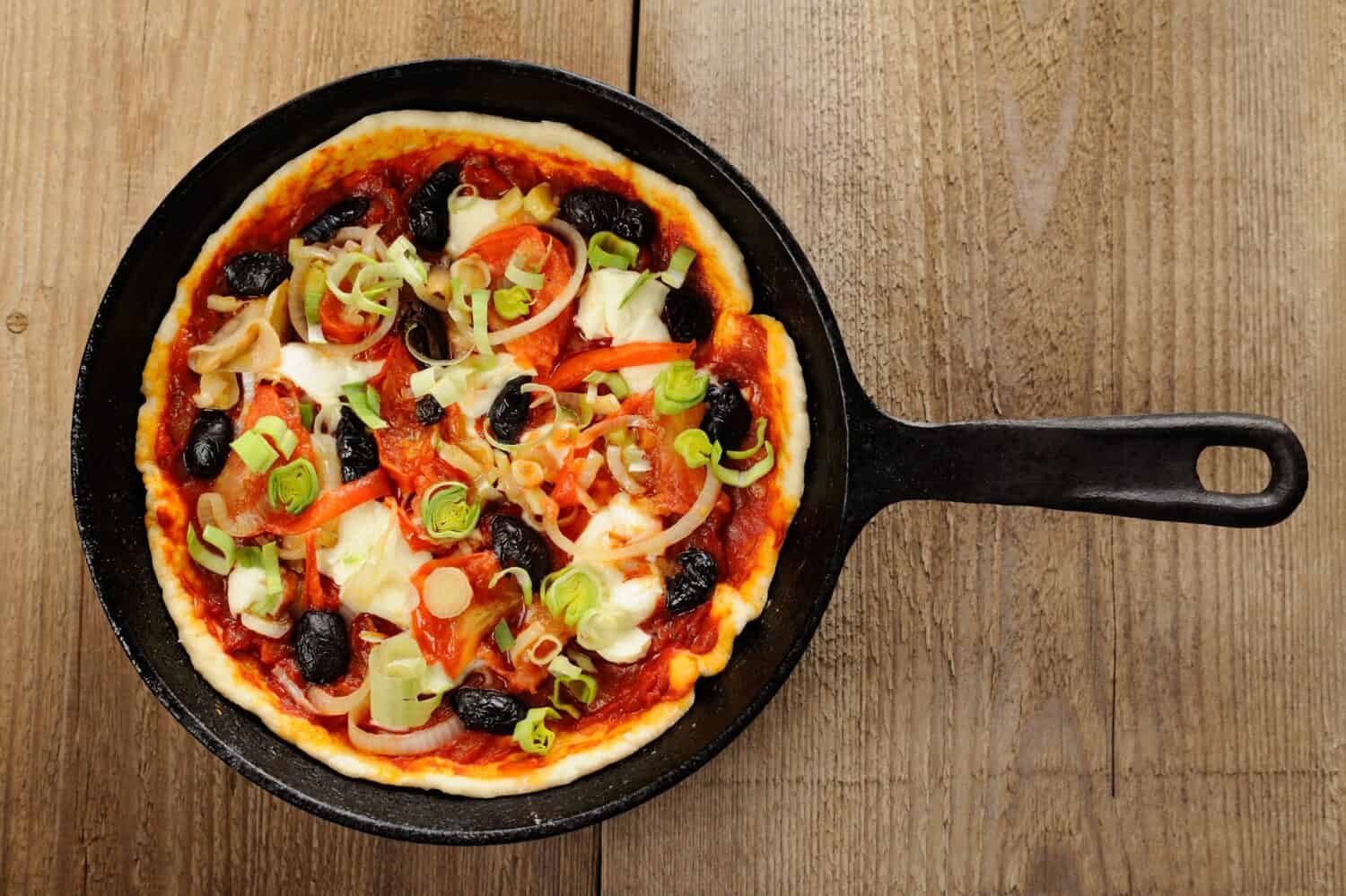
©Alexey Borodin/Shutterstock.com
Cast irons are pretty good at conducting heat. They heat up quickly compared to pizza stones, which take time before they can heat and absorb the heat. This simply means cast iron stones can cook your pizza in shorter periods.
Cook time
Since cast iron pans heat faster, they tend to have a shorter cooking time. The fact that they also retain most of the heat makes them cook faster. Pizza stones may take longer to cook your pizza.
Budget
When it comes to budget, pizza stones are generally more affordable compared to cast iron. This is mostly because cast irons are made using sturdy and heavy-duty materials. However, there are some expensive pizza stones depending on the quality.
Some of the most expensive pizza stones feature a pre-seasoning that prevents food from sticking to the pan.
Extra functionality
Both pans have versatile uses. They can both be used to cook a wide range of dishes. Pizza stones might not be used over oven stove burners, which limits their uses. But cast iron can be used over stove tops and griddles without damage.
While cast irons seem to have extra functionality, both pans seem to have a high degree of versatility.
Thermal shock/Durability
Pizza stones are more susceptible to thermal shocks since they are made of ceramic or clay. There is a higher degree of ceramic pans shattering and breaking due to thermal shock.
This is the opposite of cast iron, which is made of heavy-duty cast iron. Cast iron can withstand high temperatures since it’s made of pretty durable materials.
Can you Substitute a Cast Iron for a Pizza Stone?
You can use your cast iron as a pizza stone for making pizza. While pizza stones are the best way to make pizza, they do take up a lot of space. Instead, cast iron can be used as an alternative.
However, you’ll need to turn it over and place it in an oven rack. Using the heated underside will give a crisp crust, just like a pizza stone. You may need to retain it inside the oven and set it to the highest heat. Do so until you feel the heat coming from the other side.
With the other side hot, you can now slide in your pizza and let it cook for a minute and a half or so. Check to see if your pizza is cooked to perfection. However, this technique tends to work with thinly sliced pizzas.
5 Best Cast Iron Substitutes
Cast iron is versatile and can work for many dishes. However, if you don’t have one, there are a few alternatives to try. But the correct substitute will depend on your recipe.
Tri-Ply Stainless Steel
Tri-ply stainless steel is our first substitute offering something close to a cast iron. Cast iron is known for its great heat distribution and retention. While basic stainless steel is also durable, it’s not a good conductor. A Tri-ply stainless with copper and aluminum makes a wonderful alternative.
With aluminum and copper being good conductors, combining them with durable steel offers something close to cast iron.
Nickel-plated Skillets
Another great option is a nickel-plated skillet. Nickel-plated skillets are a type of cast iron and can be used for almost any recipe. The skillets don’t require any seasoning as their surfaces come pre-coated.
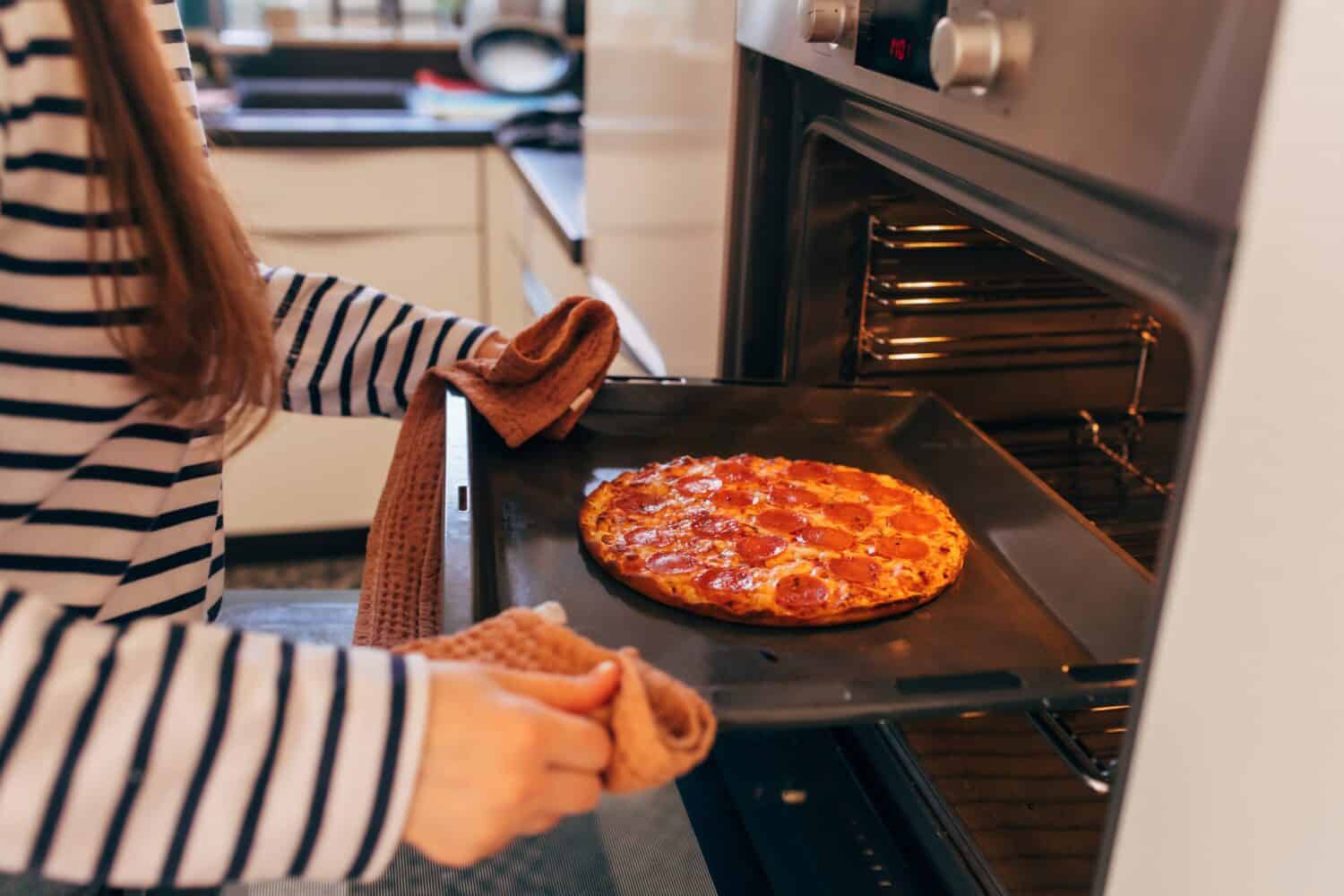
©Anton Mukhin/Shutterstock.com
The plates are oven-proof and can be used in making pizza. However, you need to check the skillet brand as their maximum temperatures may vary from time to time.
Dutch Ovens
Dutch ovens are other excellent substitutes for cast irons. The ovens are cylindrical and built using heavy materials. They work well for recipes that require cooking, braising, and baking.
The ovens are versatile and can be used in the kitchen and oven. Heat distribution on Dutch ovens is multi-directional, much more like cast irons. However, there are two types of Dutch ovens. These are the bare cast and enameled.
Bare-cast enameled ovens are the preferred choice and can withstand high temperatures. Enameled ovens are not the best choice since they don’t conduct heat well.
- Dual Handles
- Oven Safe up to 500° F or on Stovetop
- Use to Marinate, Cook, Bake, Refrigerate and Serve
Sauce Pans
Saucepans are also a great alternative if you’re not planning to use them in the oven. They can be used to make sauces, soups, gravies, stews, or textured foods.
The pans feature high sides, offering an increased cooking surface area. There are different types of saucepans, ranging from cast iron, aluminum, stainless steel, and copper.
You may want to consider stainless steel saucepans as they are non-stick and can withstand high temperatures.
Pyrex Casserole Dishes
These dishes are made of borosilicate glass and are another substitute for cast iron. The dish is more durable and can withstand high temperatures just like cast iron. They also feature non-stick casseroles for easy cooking and cleaning.
Pyrex can withstand high oven temperatures of up to 450ºF. This makes them a great choice when making homemade pizza.
5 Best Pizza Stone Substitutes
A quality pizza stone helps you create a cracker-crisp crust pizza that’s cooked all the way through, to perfection. But if you don’t have a pizza stone, there are some great alternatives.
Inverted baking sheet
The is often an alternative for pizza stone that most people turn to. You can use a rimmed baking sheet and invert it on the lowest shelf of the oven. The surface of the baking sheet will get hot enough and heat up your pizza to your desired level of crispiness.
A hot grill
If you enjoy grilled pizza, you’ll love the hot grill. These are ideal since they can withstand high temperatures. Hot grilled can produce charred-crusty and crispy pizzas in a short period due to the high temperatures.
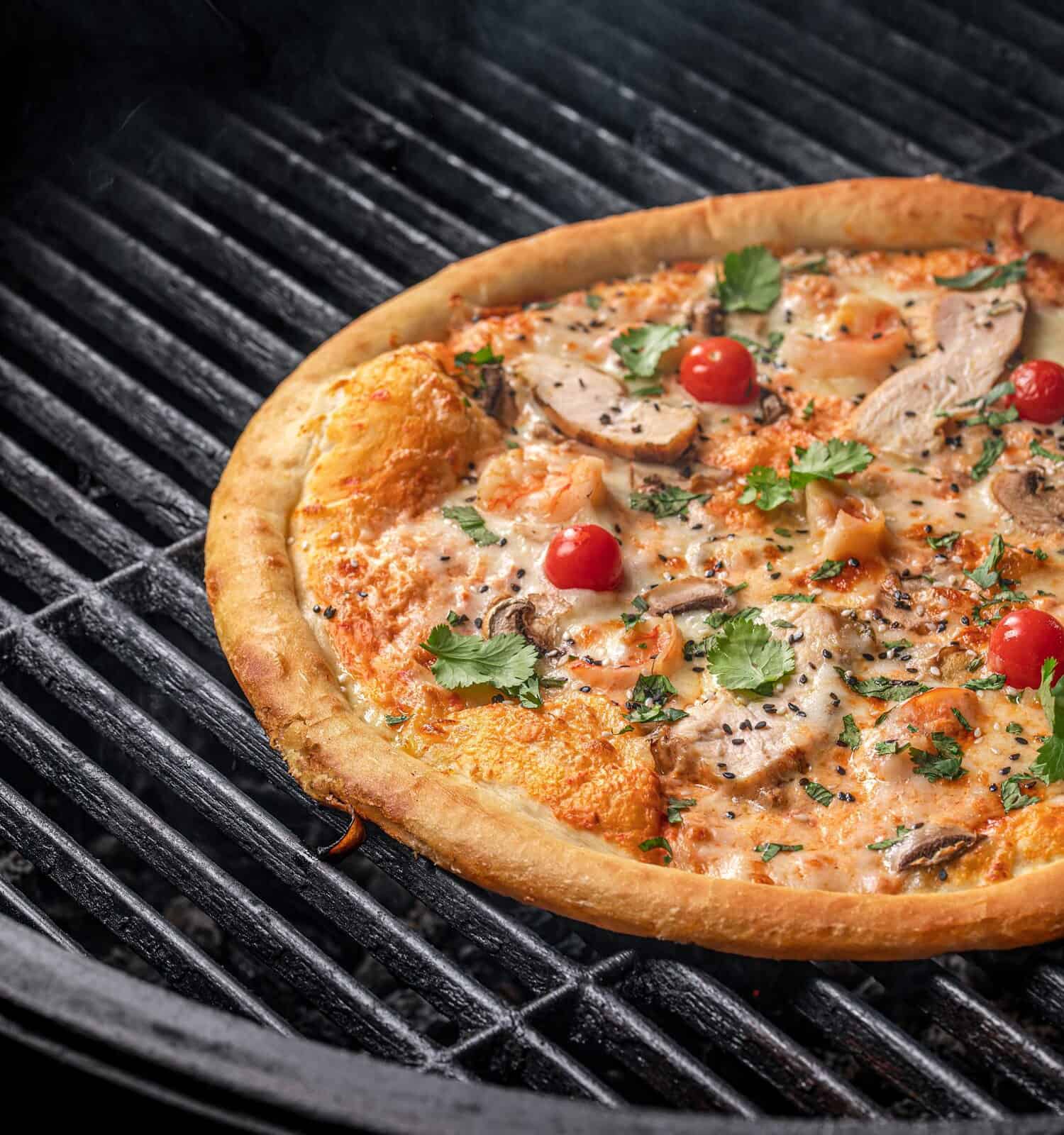
©Aleskeroff/Shutterstock.com
It’s good to have them due to their convenience, especially when hosting a party. You can make as many pizzas as possible within a short period.
Cast Iron pan
Cast iron pans may also be used to make pizza on stove tops as a pizza stone alternative. The pans are usually pre-heated upside down, more like the inverted baking sheet.
Turning them upside down and heating them helps replicate a pizza stone. However, make sure you set it on a sheet pan for easy use and safety.
Pizza pans
These are also great alternatives for a pizza stone. The pans are heavy-duty and heat very fast. They can heat up to extreme temperatures, which saves time when making your pizza.
Baking steel
Lastly, you can consider baking steel. Baking steels are heavy-duty pieces of steel used in hot ovens. They are not a common item in the kitchen but may work well for you if you can find one.
Cast Iron and Pizza Stones: Which One is Better for Homemade Pizza?
Cast iron and pizza stones have their own pros and cons. Both are great at making homemade pizza. But the ultimate choice of the best boils down to personal preference.
A pizza stone is your best choice if you enjoy crispy and evenly cooked pizza. But if you enjoy the chewy crust and slightly charred pizza, cast iron would work perfectly.
When choosing the right pan, you’ll need to consider the right size and shape. Cast iron pans come in different shapes and sizes to suit different user needs. But there are not many choices for pizza stones.
Overall, regardless of your decision, you can make delicious pizzas with the right technique and equipment.
Comparison of Cast Iron vs. Pizza Stone
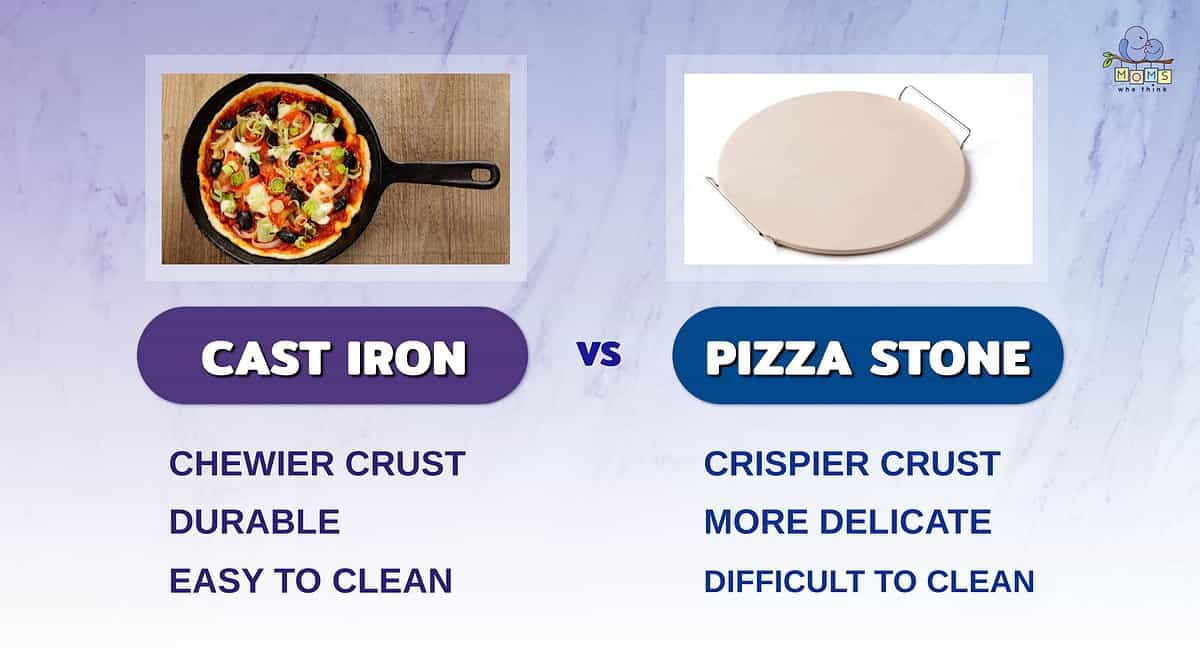
There are many different variations on how to make a pizza. While the result is still delicious and cheesy, the type of pan you use will affect the result. Here's a recap of some of the differences between a cast iron pan and a pizza stone:
- When making pizza with the pizza stone, it's important to preheat it for 30 minutes. On the other hand, cast iron hands heat up pretty quickly.
- Cast iron pans are typically easier to clean compared to pizza stones, which are more difficult to clean.
- If you want your pizza to have a thinner, crisper crust, opt for a pizza stone. But if you love thicker, chewier crusts, make your pizza with a cast iron pan.
- Comes With Free Wooden Peel
- Extra Large 15 x 12" Inch Durable Cordierite Cooking Stone
Homestyle Beef Pan Pizza
Ingredients
- 13–3/4 ounces refrigerated pizza dough
- 1/4 pound 95% lean ground beef
- 3 Tablespoons finely chopped onion
- 1 cup pizza sauce
- 2 teaspoons Italian seasoning
- 2 cloves garlic, minced
- 1/8 teaspoon ground red pepper
- 1/2 cup sliced mushrooms
- 1 1/2 cups shredded mozzarella cheese
- 2 Tablespoons finely grated Parmesan cheese
Instructions
- Preheat oven to 425°F. Lightly spray a 12-inch pizza pan with nonstick cooking spray.
- Unroll pizza dough; press onto prepared pan, with edges slightly rolled. Prick dough all over with fork.
- Bake 7 to 10 minutes or until lightly browned.
- While crust is baking, brown ground beef with onion in large skillet over medium-high heat, stirring to break up meat. Drain fat.
- Combine pizza sauce, Italian seasoning, garlic and red pepper in a small saucepan over medium heat; bring to a boil.
- Reduce heat; simmer, uncovered, about 8 minutes or until desired consistency. Remove pizza crust from oven.
- Spread tomato mixture evenly over pizza crust. Sprinkle with ground beef mixture and mushrooms. Sprinkle with cheeses.
- Return pizza to oven and bake 5 to 8 minutes more, or until heated through.
